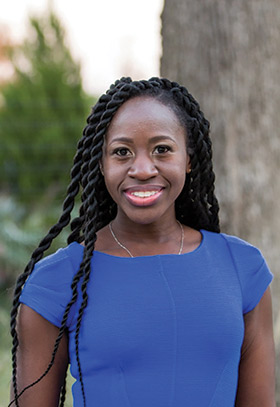A Medical Physicist’s Journey
Fall
2021
Feature
A Medical Physicist’s Journey
Introducing Julianne Pollard-Larkin
2022 Physics Congress Plenary Speaker
Korena Di Roma Howley, Contributing Editor
 When a cancer patient undergoes radiation therapy, among the team of specialists involved in planning and executing treatment is a clinically trained medical physicist.
When a cancer patient undergoes radiation therapy, among the team of specialists involved in planning and executing treatment is a clinically trained medical physicist.
If you were unaware that physicists have a key role in radiation oncology, you’re not alone. Julianne Pollard-Larkin was a rising senior at the University of Miami studying physics and math when her mother was diagnosed with breast cancer. On day one of radiation therapy, the medical physicist on her mother’s treatment team introduced himself to Pollard-Larkin. “Once I realized that we could use our physics skills to save lives, I was set for life,” she says.
Already drawn to STEM while growing up, Pollard-Larkin recalls the moment it became clear that physics was the particular path she needed to pursue: seeing Mae Jemison on the cover of a magazine in 1993, the year after Jemison became the first Black woman to travel to space. “I decided if I ever wanted to be as awesome as [Jemison], I had to go for the hardest specialty,” she says. “And physics is the hardest field there is.”
In high school, Pollard-Larkin got her first lesson in just how hard physics can be, not because the concepts can be difficult to grasp but because her ability to grasp them was deeply underestimated. “My physics teacher did not see a whole bunch of potential in a young group of Miami high school students,” she says. “[It] was the first time in my life that I ever had any type of instructor, teacher, or professional in education look at me and be quite open about their bias.”
Pollard-Larkin’s response was to double down on the subject. “It just made me even more excited about it,” she says. After graduating from the University of Miami, she went on to receive a PhD in biomedical physics from the University of California, Los Angeles. Today she’s an associate professor of medical physics at the MD Anderson Cancer Center at the University of Texas, where she’s engaged in both clinical work and academic research. She also volunteers much of her time, leading diversity and inclusion efforts for the American Association of Physicists in Medicine (AAPM) and being involved in outreach activities at conferences and other events.
Since Pollard-Larkin began her career, she’s seen diversity in the field evolve. Over the past two decades, for instance, the percentage of women in medical physics graduate programs has grown. “I love being part of that whole generation,” she says. “Seeing that happen just on the gender scale really changed things for me.” Now Pollard-Larkin and others are continuing this effort by working to expand racial and ethnic diversity in the field as well.
Still, racial and gender biases continue to present hurdles for students from underrepresented groups. “The idea that you would just have to get over not feeling comfortable, not feeling welcome, not being asked to provide your input, not being taken seriously when you have a question or even a remark—that takes a lot out of you,” Pollard-Larkin says. “The reason I decided to persist in spite of that was because [I knew] just how exciting my future could be if I were to continue on.”
For Pollard-Larkin, finding a mentor was key to overcoming some of the more insidious issues that can close doors for underrepresented students. “Every person needs not just a mentor but also an ally—somebody who will actually put their own skin in the game for you,” she says. “You need someone to see your potential outside of yourself and your own family, because that’s the person who’s going to remind you that this is possible.”
A lot of the effort, Pollard-Larkin says, must come from students themselves. She emphasizes the importance of attending conferences, ensuring that a particular passion is well articulated, and finding community, even if it’s necessary to look beyond one’s immediate environment to locate it. “Use the internet to its full capacity,” she says. “There are so many ways to get connected right now.”
Most importantly, Pollard-Larkin encourages students to find people who help provide strength, rejuvenation, and encouragement, and to put a spotlight on their backgrounds, achievements, and unique qualities. “When it comes to your future,” she says, “leave nothing on the table.”
